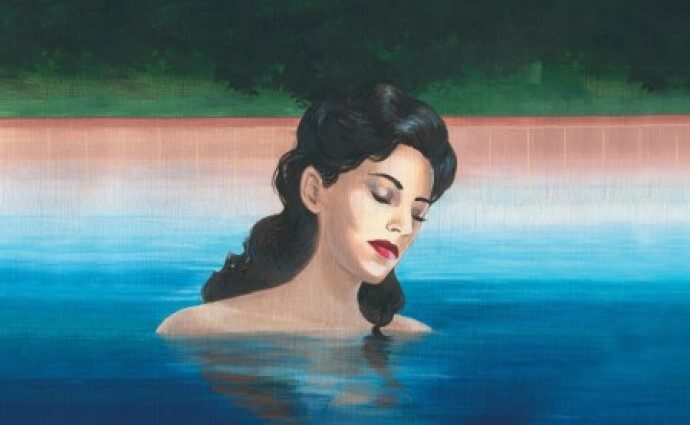The concluding volume of Europe Comics’, Anastasia, a story of a young starlet who has successfully climbed the glass mountain called Hollywood, only to find that it’s pretty hollow at the top, packs in a lot of emotion and a lot of truth about the horrors of the movie business, aided by stunning art to boot.
Anastasia: Part Two
Joanna Karpowicz (art); Magdalena Lankosz (story)
Europe Comics
May 20, 2020
Anastasia’s exposé of the nightmare world of Hollywood in its golden age will likely not provide new revelations to those in the know. Hollywood has been profiting off of its own checkered past for centuries, from the cheerful smiles-and-sunshine that cover up the true terror that took place during the silents-from-sound transition in Singin’ In the Rain to the justifiably angry look at the abusive studio system that churns the wheels for Inside Daisy Clover’s foul-mouthed ingénue. But Magdalena Lankosz – a feminist filmmaker, writer and critic in her own right — has something that’s nonetheless important to say about life in Depression-era Los Angeles, and the result — thanks to lush canvas paintings by Joanna Karpowicz — is edifying and interesting.
Anastasia is a young starlet whose mother brought her to Hollywood in 1926 with the hope of her becoming a child star — like the famous real-life kid star Baby Peggy. Anastasia does end up achieving her mother’s goal — but became the subject of vile sexual, physical and emotional abuse at the hands of various directors and producers in the first part of the story. Those events are summarized again for readers here in bruising, heartrending flashbacks.
When we join up with her once more in 1937, Anastasia has grown up to become a troubled young woman who is forced to participate in casting couch culture. She uses doctor-prescribed cocaine to cope with her traumas. Driven by a successful nationwide war bond selling tour with other starlets, Anastasia develops an ambition to become a different sort of actress and arranges for a meeting with legendary real-life producer/director Mary Pickford – who becomes Anastasia’s mentor. But Anastasia makes the mistake of blurting out her feelings about life in the studio system to viperous real-life gossip columnist Hedda Hopper, who arranges for her fall. When her replacement is murdered Black Dahlia style, her mother does something unforgivable to secure Anastasia’s place in the Hollywood pecking order — and fragile Anastasia finally snaps.
If you’re looking for some kind of relief from the endless downer that 2020 has been, Anastasia is not the graphic novel you’re looking for. For the majority of the book, it’s a deep, dark exploration of a woman who has been beaten down by the Hollywood system, and the aftereffects of pedophilia on her psyche. The ending redeems the inky blackness that pervades the story, but the journey to get there is a long one.
That does not mean it’s poorly written or drawn by any stretch of the imagination. Anastasia is a beautiful novella, with great feeling for its subject and a good handle on life in Depression-era Hollywood.
Anastasia is a sympathetic figure — bright, damaged, broken, but not bowed. The people around her are wolves, rejecting if not vicious, and the poor girl has nary a single real friend. If she’d had one, perhaps the narrative would’ve been better balanced, but the noirish conga line of misery begins to grate until the hopeful ending emerges (or at least I hope it’s a hopeful ending and Anastasia will not do what her mother has done unto her).
Karpowicz’s art is definitely the star of the series. In large, beautiful canvas paintings, Anastasia’s life spirals out in surrealist but beautiful canvasses of nightmarish tension. The style is unique, indelibly 30ish in tone but also unlike nothing I’ve ever seen before, with touches of comic book surrealism and pop art beauty. It’s Eisner worthy in and of itself.
In tones of grey and blue and green, an almost mildewed and moldy old shades, Karpowicz plays out the sordid tales of Anastasia’s youth. Urgent, sensitive and dramatic, her work is so outstanding you’re guaranteed to be stunned by it.
You have to be in the right mood for a book like Anastasia. But if you are ready for something heartbreaking, glorious and painful, then I highly recommend it.
CW: on-page rape, implied underage rape and molestation of a child/pedophilia, disordered eating, drug use and suicidal ideation. Graphic murder. Explicit sexual content.


